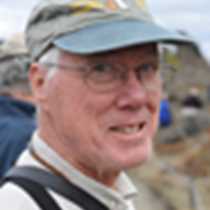The Gerlache Strait, Antarctica
We have reached the west side, the snowy side of the Antarctic Peninsula. Moisture evaporated from the open sea is carried here by the Westerly winds, and it falls as snow. Over the years, layer by annual layer, the snow accumulates to form ice. Ice forms the glaciers that descend down the steep slopes (for, by definition, a glacier is a moving stream of ice) and the moisture, now in the solid state, is returned into the ocean from which it came. Icebergs are eroded by wind and waves, and by the warmer (or perhaps less cold) water and air of the short Antarctic summer. Gradually, they become smaller. Their center of mass shifts. They rock, and then they roll. Down becomes up, revealing the dimpled texture of ice that has been eroded by water. Dense ice, lacking in air bubbles, reveals a fantastic blue color as longer wavelengths of light are trapped within; only the shorter wavelength blues are sent back to our eyes and to the sensors of our cameras. Ice below the surface (most of the iceberg), seen through the water, is a soft jade green of unimaginable beauty, bringing gasps of delight from the viewers. All around us, on steep slopes and in the water of Cierva Cove, we are surrounded by evidence of this hydrological cycle of water, snow and ice.
Floating ice serves as resting platforms for Antarctic seals. In our zodiac cruises around Cierva Cove we encountered two Weddell seals resting on the ice. These are the deepest divers of the Antarctic seals, staying down for periods that may exceed an hour, but when they rest, they do it seriously! These two were using a large piece of snow-covered glacial ice for an extended siesta. We were able to approach, view, photograph, and depart without budging them from their chosen spot. It is our pleasure to view the wildlife and leave the animals undisturbed.
But today will go down as the day of the leopard seal. We found a male resting on a small piece of sea ice, first from the ship and then from our Zodiacs. We had to push our rubber craft through thick brash ice to reach the seal, but it was entirely worth it! Weddell seals have a head that seems to be three sizes too small; leopard seals, in contrast, have an outsize, triangular head, with a sinister, reptilian smile. Their huge mouths tell a story of a mixed diet: large, sharp canines, the better to kill penguins and the pups of other seals, and premolars and molars that form a perfect sieve for the capture of krill. In fact, krill form the major part of the diet of leopard seals. Most exciting of all, this leopard seal was vocalizing with a series of moans, gongs and trills. How I wish that this was an auditory expedition report and I could share with all readers the haunting, spine-tingling sounds of the seal! There is no reason to think that the sounds were addressed to us. Rather, I suspect that they were a consequence of reproductive hormones and his hope for one more encounter with a receptive female before they are all made pregnant and the annual breeding season has ended. In our afternoon excursion at the Enterprise Islands, by yellow kayaks and by Zodiacs, we found a younger male leopard seal, this one in the water hanging around a favored "bergy-bit" (smaller than an iceberg, larger than a growler.) The seal was behaving rather like a young puppy, rolling in the water and mouthing a piece of ice that it pushed across the water with its nose.




